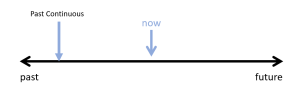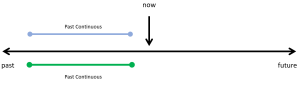10. Past Continuous Tense
Learning Outcomes
After completing Chapter 10, students will know how to:
- use the functions of the Past Continuous Tense.
- form the Past Continuous Tense in affirmative statements, negative statements and questions.
- apply the Past Continuous Tense in various situations.
- use the correct spelling rules for continuous verbs.
- use the Simple Past Tense with the Past Continuous Tense.
Functions of the Past Continuous Tense
The Past Continuous Tense is used for:
- actions happening at a specific time or during a quick action in the past.
- actions that were ongoing over a period of time in the past.
- actions happening at a time in the past when another action interrupted.
- two actions happening at the same time.
Let us discuss these points in detail.
Actions happening at a specific time in the past:

Actions that started and were occurring at a certain point of time before now. They started before the specific time or quick action, and continued after. Some examples are:
- I was cleaning my house at 1:00pm yesterday.
- They weren’t washing their dishes at noon.
- Sarah wasn’t working at midnight.
- It was snowing at the time of the accident.
Actions that were ongoing over a period of time in the past:

- I was taking Spanish lessons when I lived in Argentina.
- She was travelling through Europe all summer.
- The Smiths were having problems with their teenage daughter last year.
- The company wasn’t making a lot of money in the last quarter.
Actions happening at a time in the past when another action interrupted (The Simple Past is used with “when” as the interrupting action):

- I was taking a bath when the telephone rang.
- Richard was playing basketball when his mom arrived.
- They were having breakfast when there was a knock at the door.
Two actions happening at the same time in the past (“while” is used to connect the two actions):

- I was taking a bath while my husband was cooking dinner.
- The dog was running around the table while they were eating breakfast
Form of The Past Continuous Tense
Let us now explore how the Past Continuous Tense is formed:
| Subject + | + was/were | + verb + ing. |
|---|---|---|
| I | was | studying. |
| Joe | was | teaching. |
| You | were | working. |
| Subject + | was/were + | not | + verb + ing |
|---|---|---|---|
| I | was | not* | eating. |
| She | was | not | playing. |
| The children | were | not * | working. |
| You | were | not | studying. |
| *was not = wasn’t | |||
| **were not = weren’t |
| Was/Were + | subject | + verb + ing? | Short Answer |
|---|---|---|---|
| Was | I | helping? | Yes, you were./No, you weren’t. |
| Was | he | jumping? | Yes, he was./No, he wasn’t. |
| Were | you | listening? | Yes, I was./No, I wasn’t. |
| Wh- question word+ | was/were | + subject | +verb + ing? |
|---|---|---|---|
| What | was | he | doing? |
| Where | was | she | sleeping? |
| When | were | you | fighting? |

Past Continuous Function and Form Review
Watch the interactive video to review form and function of past continuous. Read the pop-ups carefully!
Past Continuous Function and Form Practice (Text Version)
Watch the video The Past Continuous | Past Progressive (5:45 minutes)
Pause at 1:20: Remember our examples from before? I was cleaning my house at 1:00pm yesterday. She wasn’t working at midnight.
Pause at 1:22: This might mean that the ‘specific time’ isn’t an actual time, but a quick action instead. The longer action continues before and after the quick one. For example: He was cooking dinner when the kids came home from school. (He started cooking before, and continued to cook after the kids came home). ‘Cooking’ was in progress when another action happened, and cooking continued to happen afterwards.
Activity Source: “Past Continuous Function and Form Practice Interactive Video” by Sari Martin, licensed under CC BY-NC SA 4.0. Video Source: First Class English. (2022, February 4 ). The past continuous | Past progressive | Free English grammar lesson 2022 [Video]. YouTube. https://youtu.be/LH-prYzG2Ug
Past Continuous Functions Review
Past Continuous Function Practice (Text Version)
Practice the functions of Past Continuous and guess which function was used in each sentence. The functions you can choose from are:
- actions happening at a specific time or during quick action in the past;
- actions that were ongoing over a period of time in the past;
- actions happening at a time in the past when another action interrupted;
- two actions happening at the same time.
- Last night I was watching TV while my husband was reading.
- She was driving when she received a phone call. She pulled over to answer the call.
- His sisters were both yelling at him for breaking their favorite toy.
- She was backpacking through Thailand last summer.
- He still wasn’t sleeping at midnight.
- She was walking in the school yard when she slipped on a banana peel.
- We were watching the movie when our food was delivered.
- The moon was shining brightly while we were driving to the farm.
- She was cooking dinner when her husband came home.
- She was talking on the phone for hours last night.
- She was teaching the lesson when a student raised their hand.
Check your Answers in footnote[1]
Activity source: “Present Continuous Function Practice” by Sari Martin, licensed under CC BY-NC SA 4.0.
Past Continuous Form Practice – Affirmative
Past Continuous and Simple Past Form Practice (Text Version)
Fill in the blanks with the correct form of the verb given in the bracket in either past continuous or simple past
- The sun _______ [Blank 1 – shine] when Catherine _______ [Blank 2 – get] up.
- We _______ [Blank 1 – drive] when suddenly we _______ [Blank 2 – notice] bad weather.
- My parents _______ [Blank 1 – meet] while they _______ [Blank 2 – study] in college.
- While you _______ [Blank 1 – take] it easy, I _______ [Blank 2 – prepare] lunch for everyone.
Check your Answers in footnote[2]
Activity source: “Past Continuous and Simple Past Form Practice” by Annapurna Madhuri, edited by Sari Martin, from “Simple Past and Past Continuous” In Effective English for Teachers by Annapurna Madhuri, licensed under CC BY-NC SA 4.0. / Converted to text and minor edits.
Past Continuous Form Practice – Negative
Past continuous – negative (Text Version)
Rewrite the following sentences in the negative form, as given in the example.
She was bringing ice-cream for us.
She was not bringing ice-cream for us.
- She was having a bath.
- We were running down the road.
- The soldiers were guarding the city.
- The children were watching a movie.
- Sharief was lying on the sofa.
Check your Answers in footnote[3]
Activity source: “Past Continuous – negative” by Annapurna Madhuri, edited by Sari Martin, from “Simple Past and Past Continuous” In Effective English for Teachers by Annapurna Madhuri, licensed under CC BY-NC SA 4.0. / Converted to text, some questions removed, and other minor edits.
Past Continuous Form Practice – Interrogative
Past continuous – interrogative (Text Version)
Rewrite the following sentences in the interrogative form, as given in the example.
She was bringing ice-cream at 7.
Was she bringing ice-cream at 7?
- She was having a bath.
- They were running down the road.
- Yuki was eating a sandwich in her room.
- Hong was cooking breakfast when the door bell rang.
- The girls were studying for the test.
- The men were going to work.
- When the war broke out, they were living in France.
Check your Answers in footnote[4]
Activity source: “Past Continuous Interrogative” by Annapurna Madhuri, edited by Sari Martin, from “Simple Past and Past Continuous” In Effective English for Teachers by Annapurna Madhuri, licensed under CC BY-NC SA 4.0. / Converted to text, some questions removed, and other minor edits.
Communicative Activity – “What’s Your Alibi?” – Crime Scene Role Play
-
Create a Crime Scene
-
Tell students a fictional event happened, e.g.:
“Last night at 9:00 p.m., someone stole the principal’s laptop from the office.”
-
Write a brief description of the crime on the board (time, location, etc.).
-
-
Assign Roles (in secret):
-
One student is the “thief” (they know they’re guilty).
-
All others are “suspects” (they were in the building when the crime happened).
-
Two students (or the teacher) act as detectives.
-
-
Preparation Time (5–10 mins):
-
Each suspect prepares an alibi using the past continuous.
-
“At 9:00 p.m., I was studying in the library.”
-
“I was talking to my friend in the hallway.”
-
-
The thief creates a fake alibi and must try to sound convincing.
-
-
Interview Time (Detectives ask questions):
-
“What were you doing at 9:00 p.m.?”
-
“Were you alone?”
-
“Who were you talking to?”
-
“What were you wearing?”
-
Suspects must answer using past continuous.
-
-
Group Discussion & Vote:
-
After questioning everyone, the detectives (or whole class) discuss the answers and try to figure out who is lying.
-
They vote on who they think the thief is.
-

Verb Tenses in Music
For a fun activity, listen to the following songs:
- Don’t You Want Me Baby by Human League
- Never Tear Us Apart by INXS
Can you hear the Past Continuous Tense in the lyrics?

Attribution & References
Except where otherwise noted, “Past Continuous Tense” by Sari Martin & Virginia McHardy is licensed under CC BY-NC-SA 4.0.
-
- two actions happening at the same time
- actions happening at a time in the past when another action interrupted
- two actions happening at the same time
- actions that were ongoing over a period of time in the past
- actions happening during a specific time or quick action in the past
- actions happening at a time in the past when another action interrupted
- actions happening at a time in the past when another action interrupted
- two actions happening at the same time
- actions happening during a specific time or quick action in the past
- actions that were ongoing over a period of time in the past
- actions happening at a time in the past when another action interrupted
-
- The sun was shining when Catherine got up.
- We were driving when suddenly we noticed bad weather.
- My parents met while they were studying in college.
- While you were taking it easy, I was preparing lunch for everyone.
-
- She was not having a bath.
- We were not running down the road.
- The soldiers were not guarding the city.
- The children were not watching a movie.
- Sharief was not lying on the sofa.
-
- Was she having a bath?
- Were they running down the road?
- Was Yuki eating a sandwich in her room?
- Was Hong cooking breakfast when the door bell rang?
- Were the girls studying for the test?
- Were the men going to work?
- Were they living in France when the war broke out?

